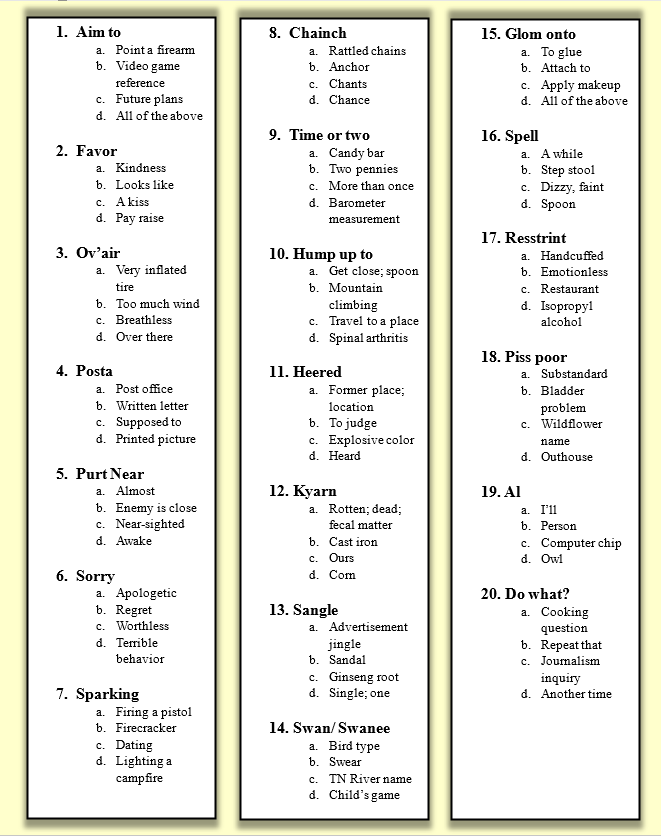Welcome to our fifth quiz in Appalachian English. I always try to write some little introduction before the quiz with a little tidbit of information about our language. Here goes . . .
The way Appalachian dialect is portrayed in media, literature, and television often discriminates against and inhibits us. In recent years, Appalachian people have refused to let that hinder them. We are proud of our dialect. States like Tennessee and West Virginia are passing bills recognizing the Appalachian dialect as a language. Many linguists, I dare to say, would likely disagree with a single language in Appalachia. Since we are a diverse makeup of people(s), we have a diverse makeup of language(s). Mountain language is distinct and unique. No one else talks like us. We haven’t always been proud of our language.
Appalachian author Silas House says “The media has taught us that dialect and bad grammar are the same thing.”1)Brashear, Ivy Jude Elise. 2016. Rural Reality: How Reality Television Portrayals of Appalachian People Impact Their View of Their Culture. Masters Thesis, University of Kentucky. They are not. We, by way of our dialect, are often the comic relief under a bell jar. And we are made to think that no one in the world understands what we are saying, as quoted by this frustrated woman:
It really upsets me when you have someone from here on the national news, or on a program or something, and they’re speaking well, and they [the producers] throw subtitles on it. I mean, it’s not like the guy on “Waterboy” that you can’t understand, you know?2)Brashear, Ivy Jude Elise. 2016. Rural Reality: How Reality Television Portrayals of Appalachian People Impact Their View of Their Culture. Masters Thesis, University of Kentucky.
Depictions of our dialect further exacerbate the oppression and discrimination we encounter. In literature outside Appalachia, “characters are shown to speak more slowly, and exhibit features that are characteristic of the dialect . . .” which “perpetuates the idea that all Appalachians are uneducated and lazy.”3)Alberts, Savanah. 2021. Hootin’ and Hollerin’: The Portrayal of Appalachians in Popular Media. Research, West Virginia University.
George Washington Harris and John Fox Jr. are two authors who are a bit heavy-handed (in my humble opinion) when it comes to mountain dialect representation. Some have said that John Fox Jr., who wrote The Little Shepherd of Kingdom Come and The Trail of the Lonesome Pine (1908) “shaped the middle-class perceptions about Southern Appalachia more than any other writer did” by building his “reputations on the presumed mountain people’s peculiarities in speech and custom.”4)Shutt, Viviana Andreescu and J. Eagle. 2009. “Violent Appalachia: The Media’s Role in the Creation and Perpetuation of an American Myth.” Journal of the Institute of Justice and International Studies 62-75.
Now don’t get me wrong here. I, as a native Appalachian, use dialect in my writings. Many, if not all, Appalachian writers do so. And I use a phonetic version of the dialect so readers can “hear” the words on the page. (Note the quiz below, for example.) Maybe I’m engaging in a dialogue double standard. I don’t know. Since our language is so unique, and since it has been absconded and thrown around like spaghetti noodles on a wall, I figure I have the right to take it back to show a better truth.
When television began, three channels had total broadcasting control: The American Broadcasting Company (ABC), The National Broadcasting Company (NBC), and the Columbia Broadcasting System (CBS). Through their television shows and news programs, they shaped public perceptions about places, peoples, America, etc. Sitcoms were a very big part of how mountain people were portrayed. The Real McCoys, The Andy Griffith Show, and The Beverly Hillbillies were massively popular in their day. And they still are. While they may show a moral compass or a quasi-defiance of social stratification, the dialect is often awkward or forced. I mean, who among us has ever heard of a “see-mint” pond? These “shows captured the dialectical relationship between the noble mountaineer and the farcical and base hillbilly at a time when real mountaineers were much in the news.”5)Harkins, Anthony. 2001-2002. “The Hillbilly in the Living Room: Television Representations of Southern Mountaineers in Situation Comedies.” Appalachian Journal 98-126. And that is how it seems to have been all along – beginning in newspaper articles from the Hatfield-McCoy feuds.
But now, Appalachian opinions about our dialect seem different. A curiosity is afoot and a pride about our language is taking hold. And that’s a good thing.
introduction written by Delonda Anderson, Chief Editor
Take the quiz below to find your score in Appalachian English! Some words have more than one meaning. Catch the answers in our next post.

Introduction Sources:
- Alberts, Savanah. 2021. “Hootin’ and Hollerin’: The Portrayal of Appalachians in Popular Media.” Research, West Virginia University.
- Brashear, Ivy Jude Elise. 2016. Rural Reality: How Reality Television Portrayals of Appalachian People Impact Their View of Their Culture. Masters Thesis, University of Kentucky.
- Harkins, Anthony. 2001-2002. “The Hillbilly in the Living Room: Television Representations of Southern Mountaineers in Situation Comedies.” Appalachian Journal 98-126.
- Jones, Patricia Smith. 1997. “Dialect as a Deterrent to Cultural Stripping: Why Appalachian Migrants Continue to Talk That Talk.” Journal of Appalachian Studies 253-261.
- Shutt, Viviana Andreescu and J. Eagle. 2009. “Violent Appalachia: The Media’s Role in the Creation and Perpetuation of an American Myth.” Journal of the Institute of Justice and International Studies 62-75.
- “Combatting stereotypes about Appalachian Dialects” by Maggie McDonald. July 2017. The Conversation.
- “The Legendary Language of the Appalachian “Holler”” by Chi Luu
**Featured Image:
References
| ↑1, ↑2 | Brashear, Ivy Jude Elise. 2016. Rural Reality: How Reality Television Portrayals of Appalachian People Impact Their View of Their Culture. Masters Thesis, University of Kentucky. |
|---|---|
| ↑3 | Alberts, Savanah. 2021. Hootin’ and Hollerin’: The Portrayal of Appalachians in Popular Media. Research, West Virginia University. |
| ↑4 | Shutt, Viviana Andreescu and J. Eagle. 2009. “Violent Appalachia: The Media’s Role in the Creation and Perpetuation of an American Myth.” Journal of the Institute of Justice and International Studies 62-75. |
| ↑5 | Harkins, Anthony. 2001-2002. “The Hillbilly in the Living Room: Television Representations of Southern Mountaineers in Situation Comedies.” Appalachian Journal 98-126. |
